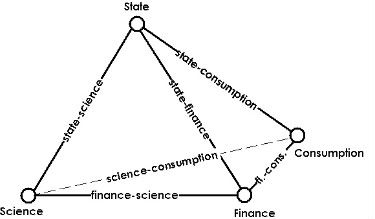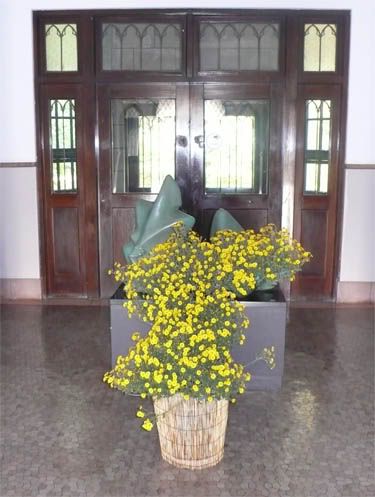Ecological Reformation: Extending Checks and Balances Beyond the Government to Maintain Ecological and Bodily Integrity

Opposing Tyranny Beyond the State: Novel Institutional Design and Institutional Coordination Principles for Science, Finance, and Consumption
Some recent tyrannous news about (carcinogenic) RFID chipping companies buying credit monitoring databases and how British police are under equally tyrannous orders to steal suspects private DNA and put it in a public database regardless of innocence or guilt findings reminded me of one of the principles of the bioregional state that all tyrannous governments break: maintaining bodily integrity. The bioregional state maintains bodily integrity.
I discussed the bodily integrity principle at greater length in a previous post:
"Codex Alimentarius's current versions, in terms of the bioregional state, cross the 'bodily integrity' line "that government shall not pass." The fuller quote of bioregional state [bodily integrity] principles, from Toward a Bioregional State's Ecological Bill of Rights, says in part:Additionally, the tyrannous news above that only works when other tyrannous versions of institutions are associated with state tyranny reminded me of the promise in the preface of Toward a Bioregional State to extend analysis of tyranny beyond the state:
"Attempts of some to pressure government to enforce certain moralities to regulate internal bodily issues are forms of bodily tyranny that break the skin barrier that government shall not pass. The Constitution of Sustainability shall assure bodily integrity through upholding bodily rights, instead of demoting them."
...[W]hat I am arguing is that these are general structural requirements for all states as they move towards sustainability....Structurally, the state in general requires changing, instead of only a change on the level of political party ideas for instance. These bioregional letters propose how existing unsustainable states could be 'made over' into sustainable states: typically, a different topic is addressed in each letter. There are 26 bioregional letters--so far. [However,]...[s]tate structures are far from the only aspect of importance [in avoiding tyranny], though they are a formal requirement. I am working on other issues beside the state--the institutional interactions between science, finance, and consumption are equally important in sustainability because the 'state' influences consumptive politics in these four issues."In the 30 minute interview I gave about the book, I talked about this as well, how a wider ecological tyranny depends upon agreeable institutional practices beyond the state and their material and developmental choices.
So Toward a Bioregional State is 'book one' dealing with state institutions that oppose ecological tyranny. It is the first book in the world on green constitutional engineering.
It implies its companion book, 'Toward an Ecological Reformation,' that is on a wider "Ecological Reformation" of institutional design and institutional interaction required in other areas to move to sustainability.
To elaborate these other institutional areas toward sustainability, first it is required to discuss why we are required to discuss novel levels of checks and balances beyond state institutions: [1] because politics is animated from other areas of institutional design beyond the state in order to keep tyrannies in place, and [2] because there are as a consequence interactive institutional practices that create tyranny and unsustainability--or alternatively, #1 and #2 can make sustainability. In short, more than state institutions create good or bad developmental policies and developmental choices.
Toward this wider Ecological Reformation, it is important to note our ecological tyrannies are this wider cross-linked tyranny agreed upon by interactive institutions beyond, though with, the state institutions. Any ecological tyranny requires unrepresentatively designed and unrepresentatively interactive institutions in four areas: state institutions, science institutions, financial institutions, and consumptive institutions.
A sustainable society has [1] institutional designs, [2] checks and balances between these, and [3] multiple simultaneous choice allowances within these categories to keep unrepresentative and unsustainable collusions and clientelism from coalescing, while encouraging coordination only via open, representative, and politically transparent ways.
The Three Dimensions of Tyranny: Political, Bodily, and Ecological
The idea is that political, bodily, and ecological tyranny depends upon the same interaction of informal power animating these four institutional design areas and their institutional alliances. (Instead of this three-fold way of thinking about it, you might more simply consider that 'ecological' tyranny involves simultaneously a material and ideological tyranny inter-merged in particular material flows linked to particular legitimating ideologies--that have their political, bodily (health), and ecological effects.)
First, an analysis of tyranny is unable to be limited to only the political institutions and human issues. It requires an analysis of how tyranny is a form of unrepresentative, unecological development effects beyond mere human and beyond mere state institutions--that of course have human health tyranny repercussions in full circle. Second, an analysis of tyranny is unable to be limited to only analysis of state institutions since states are unable to be a tyranny by themselves. They require equally tyrannous institutional designs and collusive behavior between unrepresentative scientific, financial, and consumptive institutions. These other areas of potential tyranny work with an unrepresentative state to create these three dimensions of tyranny.
This means that sometimes maintaining this bodily integrity requires maintaining ecological integrity. This means that opposing tyranny in the state goes beyond mere state design suggestions. To achieve sustainability is to offer novel checks and balances for the institutional design and the institutional interactions between state, science, finance, and consumption institutions.
That is one of the arguments of Toward a Bioregional State and its "book two" in progress which has examples of [1] institutional design frameworks to achieve this in these additional areas, [2] conceptualizes how to maintain checks and balances against their degradative institutional collusions to avoid politicized clientelism, and [3] how to have multiple institutional alternatives (in each of the consumptive categories for wider consumer choice; and in the four areas of state, science, finance, and consumption to maintain regional institutional practices capable of constructing their own optimal interests in particular areas).
This implies that to avoid political, bodily, and ecological tyranny requires a larger Ecological Reformation of 'the four sovereigns' and how they interact. Most political science reductionistically limits analysis to state institutions and only human-to-human relations. These are only a small part of how political power is exercised through the other three institutional forms' practices and design motifs as well as through particular politicized materials and technologies as a consumptive infrastructure.
Political, bodily, and ecological tyranny can be their unrepresentative interaction, or sustainability can be their interaction via checks and balances against degradative material regimes of collusion.
In the introduction's examples, checks and balances on one consumptive material corporation (VeriChip) from owning another 'science/knowledge/database' gathering corporation (Steel Vault) is one example. The other example would be checks and balances on state power (the British state) from being able to gather material DNA, the material/consumptive position. Keeping these institutions separate maximizes greater public input from particular regions instead of regimes of centralized political power, knowledge, and materials flows as clientelism. Another example would be how oil corporations would be checked and balanced from buying up their functional alternatives in the energy category (and mostly, just refusing to utilize them, thus securing their political clientelism in the energy category via oil as a form of tyranny). The same check and balance within the consumptive category would keep genetically modified crop (consumptive) corporations from (a) being half owned by the state (like in the case of some of them) or from buying up their functional equivalents (natural seed companies) in the same consumptive category (and refusing to sell them, just to have more control and clientelism in the reduction of choice arrangement they desire in their consumptive category). All these checks and balances would reduce very real frameworks of political tyranny that is exercised outside of exclusive state institutions.
Another recent example of this form of collusion between science institutions, informal state elites, and corporate ownership as an interlocked as tyranny is the "Climategate" issue: that there are various Al Gore financial kickbacks created behind the scenes, justified by a climate science that is heavily partial and even conspiratorial (and see this) instead of based on open peer review as real science is. Meanwhile, Gore's corporations are being funded by the federal government in the process--three levels of tyrannous collusion that is without political transparency:
"Yesterday we reported on how Gore was set to become the first "carbon billionaire" on the back of vast profits from companies invested in the "green revolution" that the former vice-president has a hefty stake in. We also highlighted how the Chicago Climate Exchange (CCX) has direct ties to both Al Gore and Maurice Strong, two figures intimately involved with a long standing movement to use the theory of man made global warming as a mechanism for profit and social engineering. Gore's investment company, Generation Investment Management, which sells carbon offset opportunities, is the largest shareholder of CCX. Gore stands to make windfall profits from his stake in carbon trading systems that would be used to manage the cap and trade system currently being readied for passage in the Senate, but his admission that CO2 is far less of a threat than global warming alarmists have been claiming could be a terminal blow for such a proposal. As Andrew Bolt writes in today's Australian Herald Sun, his flip-flopping "Suggests not only that was Gore wrong to claim the science was "settled", but that the hugely expensive schemes to "stop" warming by slashing carbon dioxide emissions will be less than half as effective as claimed."I'm interested in demoting polluting, corruptible, and degradative raw material regimes as much as the next guy. We can do it because all the solutions for sustainability already exist. I note many at Toward a Bioregional State's companion blog, Commodity Ecology. There I list 89 categories of consumptive use and the more sustainable technologies and materials that already exist, waiting to be applied. The technology and materials for sustainability have been available for decades, though left unapplied. I suggest we look to political corruption around status quo raw material regimes in their categories as the rationale why we are denied local optimal solutions for sustainability. Solving political tyrannies is of the first order--to be a good ally for those introducing the sustainable technologies we already have available.

However, back to the carbon regime of tyranny, to create a novel tyranny sold as a solution is counterproductive and will only contribute to unsustainable politics by soldering together a form of repressive, exclusively centralizing institutions that merely claim to be dealing with environmental issues, when their centralization will be a cause of future forms of political tyranny and ecological tyranny as well.
There are at least four rings in the environmental circus (i.e., four ways to respond to environmental crises), and the bioregional state solutions toward more local representation of ecological self-interest by freeing up technologies and local optimal uses of them and encouraging removing political corruptions that maintain unsustainably are in contrast to corporate media suggestions of tyrannous arrangements that remove local optimality despite being sold as environmental solutions.
The Four Unrepresentative Institutions of Tyranny: State, Science, Finance, and Consumption; or the Four Representative Institutions of Sustainability with Different Institutional Designs
Ecological Reformation is the wider argument that ecological tyranny requires solutions inclusive of though beyond state-level political tyranny to solve. States are only one quarter responsible for ecological tyranny, since ecological tyranny is a series of other institutional designs and top level personnel exchange and policy coordination between between how state, scientific, financial, and consumptive institutions work together to construct such a tyranny (typically recycling the same people in different positions to "HARMonize" everything) that destroys political, ecological and bodily integrity. Over time, this destroys the state itself through lack of legitimacy that I discuss this historical process of organizational blames for environmental degradation in my recent book Ecological Revolution (2009).
So a wider Ecological Reformation assuring both design and interactions of 'the four sovereigns' avoid institutional and personnel collusion is required to address these interactive issues of avoiding political, bodily, and ecological tyranny. Otherwise, environmental degradation processes are just another form of 'normal accident' from a tightly coupled system of corruptions.
Therefore the bioregional state is required to recommend a wider Ecological Reformation: a series of more sound institutions for more political, bodily, and ecological protection, in more sound versions of scientific institutions, financial institutions/instruments, and consumptive institutions taking into account their interactions with each other in a larger social context that can either encourage environmental degradation or environmental sustainability.
The current environmentally degradative hegemonic versions of state, science, finance, and consumption are collusive forms institutionally speaking, and lead toward an historical environmental degradation processes.
Other versions of institutional design and institutional interaction checks and balances are suggested in future posts. This is the first in a multi-part series detailing institutional adaptations and ideas for how to generate checks and balances in areas of state, science, finance, and consumption to avoid the forms of environmental degradation through collusive unrepresentative clientelism limiting our choices in these areas--toward mass support of only what tyrants allow materially.


